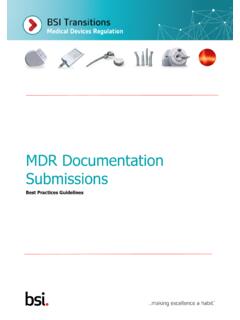Transcription of Privacy Best Practices for Consumer Genetic Testing ...
1 Privacy best Practices for Consumer Genetic Testing Services July 31, 2018. 1400 Eye Street, NW, Suite 450. Washington, DC 20005. Table of Contents Introduction .. 1. I. Transparency .. 3. II. Consent .. 4. III. Use and Onward Transfer .. 7. IV. Access, Integrity, Retention, and Deletion .. 7. V. 9. VI. Security .. 9. VII. Privacy by Design .. 9. VIII. Consumer Education .. 10. Annex A: Annex B: Legal and Regulatory Guidance ..13. Annex C: Genetic Data Sharing Policies .. 16. About the Future of Privacy Forum .. 19. Page 1 | July 2018. Introduction Consumer Genetic and personal genomic Testing are tests that are marketed to Consumers by private companies. This type of Testing has increased Consumers' access to and control of their Genetic Data; empowered Consumers to learn more about their biology and take a proactive role in their health, wellness, ancestry, and lifestyle; and enhanced biomedical research efforts.
2 The Consumer Genetic and personal genomic Testing industry is producing an unprecedented amount of Genetic Data, which provides the research community the ability to analyze significantly larger and more diverse range of Genetic Data to observe and discover new patterns and connections. It also enables researchers to gain a better understanding of the role of Genetic variation in our ancestry, health, well- being, and much more. Today, more Consumer Genetic and personal genomic Testing services are available than ever before, prices for Testing are becoming increasingly affordable, and the speed at which Testing is completed is accelerating. As the industry continues to expand and the technology becomes more accessible, it is vital that the industry acknowledges and addresses the risks posed to individual Privacy when Genetic Data is generated in the Consumer context. Given the potential benefits that Consumer Genetic and personal genomic Testing can provide to Consumers and society, it is important that this data is subject to Privacy controls and used responsibly.
3 The best Practices provide a policy framework for the collection, retention, sharing, and use of Genetic Data generated by Consumer Genetic and personal genomic Testing services. These services are commonly offered to Consumers for Testing and interpretation related to ancestry, health, wellness, Genetic relatedness, lifestyle, compatibility, and other purposes. This document applies to Genetic Data, as defined in Annex A, which includes any data that concerns information about an individual's inherited Genetic characteristics, including at least Raw Data, the Report of the Analyzed Data, and Self-Reported Health This document recognizes that Genetic Data is sensitive information that warrants a high standard of Privacy protection because of the following reasons: - It may be used to identify predispositions, disease risk, and predict future medical conditions;. - It may reveal information about the individual's family members, including future children.
4 - It may contain unexpected information or information of which the full impact may not be understood at the time of collection; and - It may have cultural significance for groups or individuals. The best Practices set a baseline of responsible Practices intended to support a targeted Fair Information Practice Principles (FIPPs)2-based framework to address the Privacy issues 1. See infra Annex A (defining relevant terms related to Genetic Data). 2. The FIPPs articulate basic protections for handling personal data and serve as a common language of Privacy and a basis for law, regulation, and international agreements. These high-level guidelines were first articulated in 1973 by the United States Department of Health, Education, and Welfare's Advisory Committee on Automated Personal Data Systems. They were codified in 1980 by the Organizations for Economic Cooperation and Development (OECD) and over time have been presented in different ways Page 2 | July 2018.
5 Related to the collection, retention, use, sharing, and research based on Genetic Data. The principles covered in these best Practices include: (1) Transparency; (2) Consent; (3) Use and Onward Transfer; (4) Access, Integrity, Retention, and Deletion; (5) Accountability; (6). Security; (7) Privacy By Design; and (8) Consumer Education. By developing these responsible guidelines, we hope to ensure continued innovation and Consumer trust within the Consumer Genetic and personal genomic Testing industry. Relevant legislation such as the Health Insurance Portability and Accountability Act (HIPAA), the Genetic Information Nondiscrimination Act (GINA), the Gramm-Leach-Bliley Act (GLBA), the Clinical Laboratory Improvement Amendments (CLIA), the Americans with Disabilities Act (ADA) and others may apply, and companies should reflect compliance with those and other applicable Privacy Practices for non- Genetic /genomic data are not addressed by these Principles, and, should reflect best Practices along with applicable federal and state legal and regulatory Privacy requirements.
6 With different emphases. See Robert Gellman, Fair Information Practices : A Basic History (Apr. 10, 2017), 3. See infra Annex B (listing primary applicable laws and regulations). Page 3 | July 2018. Privacy best Practices for Consumer Genetic Testing Services I. TRANSPARENCY: Provide clear and complete information regarding the Company's policies and procedures for the management of personal data (personally identifiable information, Genetic Data, and protected health information) and de-identified a. Privacy Notices: Privacy policies should be prominent, publicly accessible, and easy to read. They should specify the Company's data collection, consent, use, onward transfer, access, security, and retention/deletion Practices . i. A high-level overview of the key principles should be provided preceding the full Privacy policy. This overview should be a short document or statement that provides basic, essential information about the Company's collection, use, and sharing of Genetic Data.
7 Ii. Policies that vary for different categories of data should clearly spell out when each applies. For example, if the policy for Genetic Data is different than that of other data ( registration data, browsing (cookies or website) tracking, and/or personal information), these policies should be described clearly and separately. b. Deidentification and Genetic Data: Deidentified information is not subject to the restrictions in this policy, provided that the deidentification measures taken establish strong assurance that the data is not identifiable. i. We note that currently, Genetic Data held at the individual-level that has been de-identified5 cannot be represented as strongly protecting individuals from re-identification, based upon existing deidentification tools and Such data may be protected in other ways and used for research with appropriate consent and security controls (See Principle VI: Security, below).
8 Ii. Aggregation of individual reports may provide strong assurance that personal data is not identifiable, if appropriate safeguards are in 4. See infra Annex A (defining deidentified information ). 5. See, , Dep't Health & Hum. Services, Office for Civil Rights, Guidance Regarding Methods for De- identification of Protected Health Information in Accordance with the Health Insurance Portability and Accountability Act (HIPAA) Privacy Rule (Nov. 26, 2012), professionals/ Privacy /special-topics/de- (presenting guidance for the HIPAA Safe Harbor Method). 6. Commercial, technical protections and capabilities are currently being developed, but to date, protections for Genetic data include strong security protocols, including removal of quasi-identifiers (demographic and other personal health information); retention separate from or without matching datasets; encryption;. access controls; and contractual restrictions on sharing and use.
9 Without a corollary dataset for matching, the risks remain minimal. 7. The Federal Trade Commission (FTC) has identified its standards for reasonable de-identification for the protection of Consumer data, encompassing three steps: 1) reasonably deidentify the data using available Practices to an extent appropriate to the sensitivity of the data, 2) commit to not attempting to re-identifying data, 3) when sharing deidentified data, contractually prohibit additional parties from attempting to reidentify (and monitor compliance). See Fed. Trade Comm'n, Protecting Consumer Privacy in an Era of Page 4 | July 2018. c. Policy Change: Policies should indicate that material changes will not be made without first providing prominent notice and obtaining Consumer consent before data is used in any manner inconsistent with terms initially provided. d. Transfer of Ownership: Policies should indicate that in the case of merger or acquisition by another entity, the successor entity is subject to these same commitments for the Genetic Data and biological sample already e.
10 Transparency Reporting: Companies should provide a public report describing requests from law enforcement for Genetic Data. Such reports should be made on at least an annual II. CONSENT: Obtain express consent for collection, analysis, sharing, or reporting of Genetic Data. a. Initial Express Consent: Initial express consent must describe data collection and uses of the commercial Genetic product or services purchased by the Consumer , including the inherent contextual uses. Inherent contextual uses . such as providing the specific Genetic analysis product or service, data use for product and service review and improvement, or new product development . should be clearly defined. Companies should clearly specify the uses of the Genetic Data, who will have access to test results, and how that data will be shared. b. Separate Express Consent:10 Separate express consent will be required for: i. Onward transfer of individual-level information ( , Genetic Data and/or personal information about a single individual) to third-parties for any reason, excluding vendors and service providers;11.










